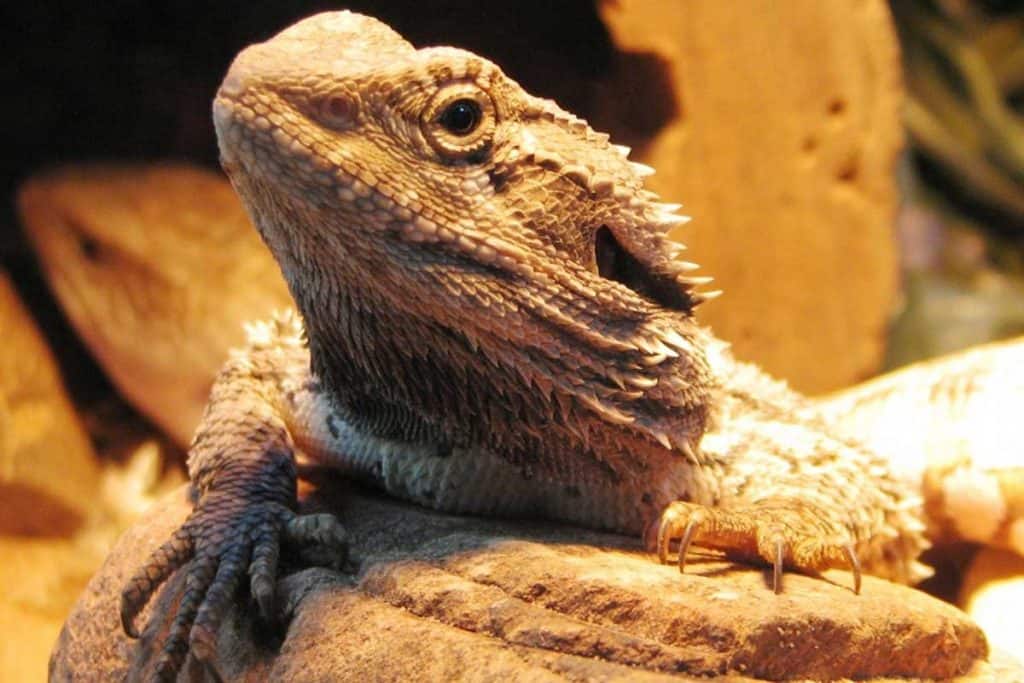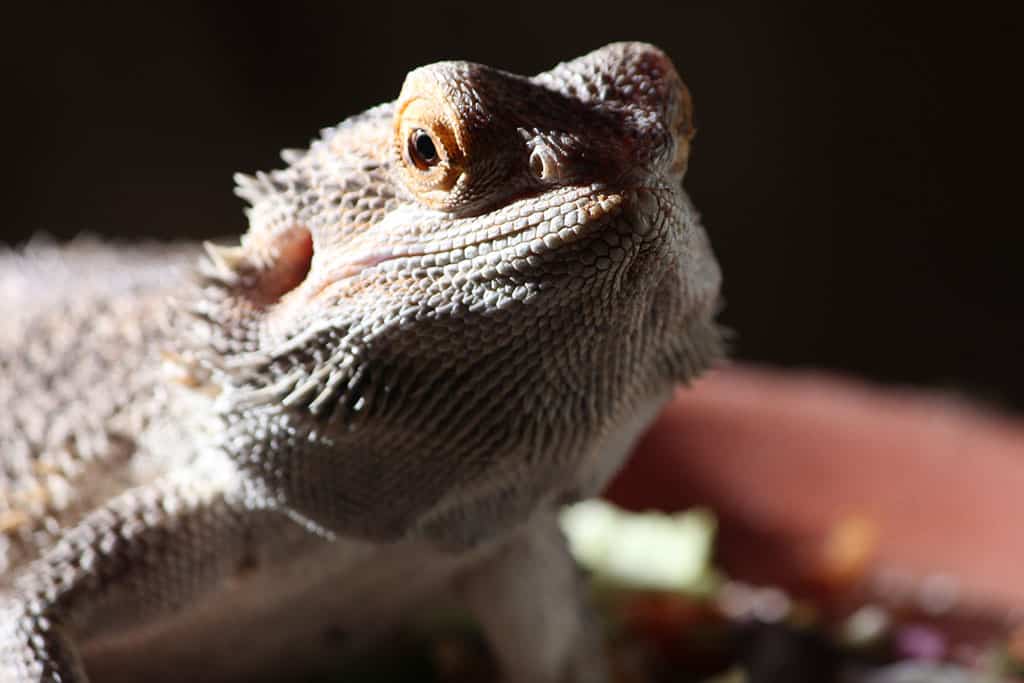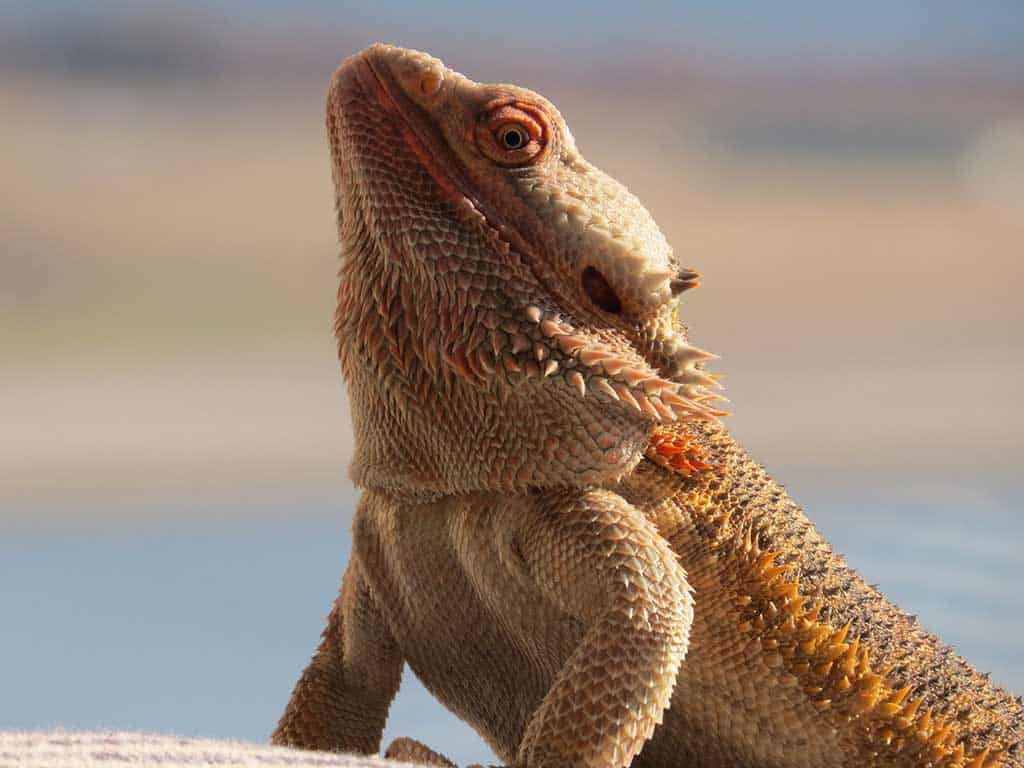Once you get over your wishy-washy worries about reptiles, owning a bearded dragon is a given. They look amazingly cool. And while they don’t breathe fire, they do puff up their throats, darken their necks, and bob their heads, so there is some dracarys there.
Bearded dragons originally came from Australia. They breed well, laying up to 25 eggs at a time. But they were over-exported in the mid-2000s so the rules are stricter now. Meaning you probably have to pay a pretty penny to own a bearded scale baby.
But exactly how much does a bearded dragon cost?
That depends on tons of factors, but expect to pay $40 to $50 on the lower end and possibly up into the hundreds or even over a thousand. This could be due to gender, age, morph, color, source, overall health, and maybe even a vet certificate. Beardies can live to 18 years, so be sure of the dragon’s age before you pay.
When you’re thinking about bearded dragon prices, though, it’s not just about buying your prospective scale baby. You also have to account for setup, which is often the biggest expense. Then you can consider vet fees, food, utility bills, substrate, and general upkeep.
These guidelines are based on a beardie named Rex. He’s now six years old, and his vet considers Rex to be his healthiest patient. So in the paragraphs to come, you’ll learn the tips that work for Rex as well as how much was spent to get him, how his habitat is kitted (with pricing), and any other expenses you can expect.
How Much Is a Bearded Dragon?
A bearded dragon’s price ranges from $50 to $800. And yes, there are reasons for this wide margin. Some of the more obvious ones are age, gender, health status, subspecies, and purchase point. After all, you could import a beardie or grab it from Petco.
A popular pet shop chain has a beardie on sale for $79.99, but the listing doesn’t give much information. So while it says the in-store beardie is a Pogona vitticeps, that’s not useful since vitticeps is the most popular sub-species. Many stores will just say ‘vitticeps’ by default. The listing also has no age.
Meaning you’d have to physically go to the shop and assess the bearded dragon. Which is always a good idea. And while they probably won’t ship the lizard, they might be willing to bring a beardie to a branch closer to you. It could still get tricky, though, and here’s why:
By the time a commercial pet store offers to move an animal for you, they probably want some proof you’ll buy the pet. So what if they ship the beardie cross-country and then the lizard ends up being too sick or too old to buy? That could land you in a no-take-backs scenario.
So while shopping online is fun and imported pets seem promising, it’s best to view the bearded dragon in person before you pay. Or at least deal with a vendor that’s willing to do live video calls, ideally on different days and under varied settings and lighting conditions.
Why does this matter? It’s easy for online vendors to use old videos or steal and crop beardie images. If your vendor allows multiple real-time video calls, it’s more likely they’re a legitimate pet dealer.
If you’re reading this article, you’re probably a scale parent who has no issue buying pets. Some activists target pet stores and breeders, though. And some animal lovers are against pet sale on principle. So check the local branch news to be sure nobody bombs the beardie store.
Buying a Beardie by Age
Many pet parents want a baby beardie. They’re more likely to imprint on you so you’ll bond better. Also, the younger you get them, the longer you keep them. With bearded dragons, babies are cheaper, so you can buy one for less than $50. A good age to buy baby dragons is 6 weeks.
You’re still safe buying a beardie up to 10 weeks of age. By size, that’s roughly 6 to 10 inches. If you’re looking at a cage full of babies, buy the biggest one in there. Their larger size means they have better genetics and/or are better at fighting for resources, so they’ll grow bigger and healthier and live longer.
But if you’re worried about raising a baby beardie, buy a grown one. They reach full size at 12 months or older and can cost $100. If you want more than one, a pair of girl dragons get along well, but they might bind their infertile eggs and fall sick. Males tend to fight, so keep them solo.
The Cost of Housing a Bearded Dragon
If you’ve watched any bearded dragon videos, you know why they’re called lap lizards. They love to snuggle and will sometimes scrabble up your neck, shoulders, and even your head. And yes, if you want your beardie getting up close and personal, you have to potty train.
How come? Well, once your beardie has bonded with you and is chilling out on your skin, there’s a chance they’ll soil you. Here’s another interesting fact: the reason your scale baby is climbing all over you isn’t just because they love you—it’s about gaining maximum height.
Remember, beardies – especially vitticeps – are semi-arboreal. They hang out in trees a lot, and in the wild you’ll see them on fence posts and tall bushes. So in your house, they’re trying to reach the highest spot on your body. This is also why perching points are crucial.
So let’s talk about bearded dragon habitats. They’re called terrariums, and sometimes vivariums. You can build one from scratch or order one in glass, plastic, or plexiglass. You want one that’s at least 120 gallons and measures 4 feet by 2 feet by 2 feet for an adult bearded dragon.
If you’re starting with a baby, you can opt for a smaller glass tank that costs less. The vendor may claim it’s fine for adults, but 51 gallons is on the lower side. Old-school beardie folk will tell you a 40-gallon to 60-gallon tank is enough, but buy as big as you can afford.
Features you might consider are sliding doors or sliding floors (like the ones in chicken houses). These are easier to maintain. Also, most terrariums come without a lid. So order a screen cover separately. Your light (UVB) and heat (UVA) lamps probably will sit on the lid.
Bigger Beardies Need Bigger Houses
If that plain glass look doesn’t appeal to you, you could try something vertical. It offers more height, but at a foot square and 18 inches tall, your scale baby will outgrow this in weeks if not months. You want something bigger for an adult, and that’ll set you back around $500.
Visit a pet store – either in person or online – and check out the different styles. There’s no ‘best’ type, so follow your gut. For conservationists, the EcoFlex is popular because it uses recycled steel and plastic-polymer. Plus, it has sliding glass doors and a screen roof.
You might be on a budget if you’re starting out. Many first-time beardie owners are students. So you might not have much space or money. Try a little travel box for your dragon to eat and sleep in. The rest of the time, they can roam around your bedroom.
Once you both have bigger homes and your beardie can get their own deluxe bioactive
How Much Is a Bearded Dragon? The Cost of Accessories
First, be clear on what your bearded dragon needs. The essentials are:
- UVA
heat lamp - UVB light lamp
- Substrate and bedding
- Water bowl and food dish
- Twigs, branches, and rocks
- Heat and humidity monitors
You’ll see a lot more beardie toys. And yes, you’ll probably buy a hammock. Rex got one! But the list above shows what your scale baby can’t live without.
Now to explore pricing and other factors.
Light and Heat
Reptile lamps aren’t purely decorative. Yes, they can help you mimic your beardie’s circadian patterns. But they also help your scale baby process
They need replacing once a twice a year when the UVB runs out. So check the pack. Also, if your lamp is on the longer side, you need to actively create shaded spots where the light can’t reach. You could get a coiled or dual dome light. Rex has one over his favorite basking spot.
You can sometimes get a regional lighting kit. It’s a set of dome lights designed to match your scale baby’s ancestral home. The pack shows what conditions it’s simulating (e.g. tropical, desert, etc.) Effectively lighting your baby’s
And if you get combo lights that give off heat as well, the cost is even lower. Still, if you want to spoil your beardie, get them a night light to boot. Most owners turn off the lights after dark. But this 60W bulb mimics moonlight, giving off a gorgeous glow plus nighttime heat levels.
We’ve mentioned the twin lamps double as heat generators. But the main heat source for your bearded baby isn’t inside the tank. Instead, your reptile room’s thermostat, windows, heaters, or air conditioners indirectly warm (or cool) the tank. Also, get a humidity gauge.
Water and Food Bowls
These can be as simple or complex as you like. Try saucers and ice cream tubs at first. Later, you can get fancy dishes, but your beardie might never use them. They may like the older ones that still have the beardie’s scent on them.
And many owners worry about leaving open water in the tank. You’d need to change it every day to avoid contamination. Or buy a covered water dish that still gives your baby access.
Twin feeders are popular as well. Plus they’re more hygienic since you’ll remember to wash the ‘food bowl’ each time you change the drinking water.
Some scale parents resist because the
Beardies also enjoy live prey, so you should throw in some insects and worms from the pet store. Don’t just grab some from the yard, though, because they could be tainted … and you can’t microwave them without killing them, so there’s no safe way to sterilize garden bugs.
Substrate and Bedding
Decide whether you want loose or solid substrate. You might think it’s better to have no substrate at all. That way, you can clean your beardie’s poop as soon as they soil. But the hard surface of tile, glass, or plastic can hurt your scale baby’s claws – zero traction!
It’s also harsher on beardie joints. And what happens when you’re away at work or at the store and your beardie needs to go potty? Your scale baby will be stuck in an open toilet for ages! Not a good look.
If you want a solid substrate, try disposables. They’re non-toxic, absorbent, and offer traction without trapping your baby’s claws. They’re cheap too, and come in packs of 25. But they’re sized for a 10-gallon tank so you’ll use a lot of them to cover your
It doesn’t have to be a particular brand. At the low end, you can mix non-sticking sand from a play pit and top soil from the garden. Or buy a commercial product that matches your beardie’s natural habitat. These come in everything from moss to walnut shells. Rex is a vitticeps so he uses a desert blend.
Twigs, Perches, and Basking Rocks
Like many pets, your beardie probably doesn’t care how expensive their toys are. They’d be just as happy with sticks and boxes – they’re like human babies that way. So look around the yard first and see what you can use. You want natural, conductive rocks for basking and naps.
You also want sturdy sticks for climbing and perching, (and back scratching?). Toss in some driftwood logs, upturned buckets with ‘doors’ cut into them, or broken planter pots. These are perfect hiding spots for when your beardie is startled or wants time to themselves.
If you’re scavenging for bioactive beardie accessories, bake or microwave them first to get rid of potential toxins. Don’t worry – they may be sterilized, but they’ll soon match the

What About Food?
Beardies need protein (worms and insects), vegetables, and a little fruit. Their diet should also include live bugs. So it can cost anything from $10 to $100 per month to feed them.
Beardie Vet Expenses
Girl beardies may need a vet visit more often than boys, so start a vet emergency fund – check-ups can cost $100 or more a visit!
FAQs
Depending on where you buy your bearded dragon, you could end up paying hundreds of dollars for items you’ll never use. Or worse, you may get a defective beardie that will die soon after getting home. So here are some common questions and answers to start your shopping excursion.
Which beardie species is the most expensive?
Only four (of the eight known) beardie sub-species are kept as pets. The most common is vitticeps, and you can get a baby as low as $30. The priciest is henrylawsoni, sometimes called Rankin’s. Those can cost upwards of $400. For snow-white morphs, expect to pay $1,000+.
How can I spend less when buying a bearded dragon?
Here are five fabulous ways to cut costs while raising Rex:
- Look online for used terrariums
- Buy your beardie from a breeder
- Get cheap wholesale veggie bags for their salads (you can freeze them!)
- Breed worms, crickets, and dubias at home
- Get a boy – their ‘hospital bills’ are cheaper than girls (due to eggs and things)
Why are the other four beardie species not used as pets?
Most bearded dragons in the US were hatched and raised by breeders. So they’re all tame. The other four species aren’t domesticated. So if you spot one, it was probably caught in the wild and smuggled, so it wouldn’t be a good household companion.
Is there any other place to find bearded dragons (apart from pet stores)?
You could adopt. Barbata and Minor Minor beardies are mostly wild, and Australia stopped exporting beardies. But because most people like brightly colored ones, the brown or tan ones are often abandoned and end up in reptile rescues. These cost way less than pet stores.
What’s the cheapest way to get a bearded dragon?
Sometimes, pet parents have to move. Or quit their jobs. Or nurse a sick relative. So they might give away their beardie. If you get lucky, you may spot their announcement online. Then you can adopt their beardie for free.
Bearded Dragon Expense Summary
The cost of buying a bearded dragon is roughly $50 to $800. But the monthly expense of keeping one can go much higher. For now:
- Bearded dragon price: $50 to $500
- Tank or habitat setup: $10 to $1,000
- Loose or solid substrate starter pack: $5 to $50
- Wet or dry starter food pack will set you back $10 to $50
If you can, buy your beardie from a breeder – not a pet store. The quality and genetics you’ll get are better. Think of it like buying your house from a builder vs buying it from a flipper.








